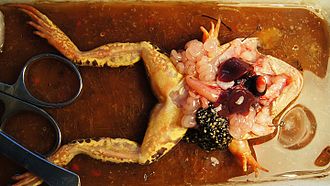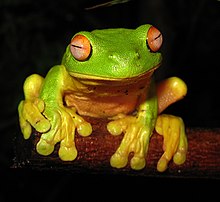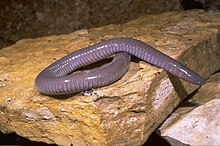
Pain is an aversive sensation and feeling associated with actual, or potential, tissue damage.[1] It is widely accepted by a broad spectrum of scientists and philosophers that non-human animals can perceive pain, including pain in amphibians.
Pain is a complex mental state, with a distinct perceptual quality but also associated with suffering, which is an emotional state. Because of this complexity, the presence of pain in non-human animals cannot be determined unambiguously using observational methods, but the conclusion that animals experience pain is often inferred on the basis of likely presence of phenomenal consciousness which is deduced from comparative brain physiology as well as physical and behavioural reactions.[2][3]
Amphibians, particularly anurans, fulfill several physiological and behavioural criteria proposed as indicating that non-human animals may experience pain. These fulfilled criteria include a suitable nervous system and sensory receptors, opioid receptors and reduced responses to noxious stimuli when given analgesics and local anaesthetics, physiological changes to noxious stimuli, displaying protective motor reactions, exhibiting avoidance learning and making trade-offs between noxious stimulus avoidance and other motivational requirements.
Pain in amphibians has societal implications including their exposure to pollutants, (preparation for) cuisine (e.g. frog legs) and amphibians used in scientific research.
Several scientists and scientific groups have expressed the belief that amphibians can feel pain, however, this remains somewhat controversial due to differences in brain structure and the nervous system compared with other vertebrates.
- ^ Broom, D.M. (2001). "Evolution of pain" (PDF). Vlaams Diergeneeskundig Tijdschrift. 70 (1): 17–21. doi:10.21825/vdt.89895.
- ^ Abbott, F.V., Franklin, K.B.J. and Westbrook, R.F. (1995). "The formalin test: Scoring properties of the first and second phases of the pain response in rats". Pain. 60 (1): 91–102. doi:10.1016/0304-3959(94)00095-V. PMID 7715946. S2CID 35448280.
{{cite journal}}: CS1 maint: multiple names: authors list (link) - ^ Key, B. (2015). "Fish do not feel pain and its implications for understanding phenomenal consciousness". Biology and Philosophy. 30 (2): 149–165. doi:10.1007/s10539-014-9469-4. PMC 4356734. PMID 25798021.


